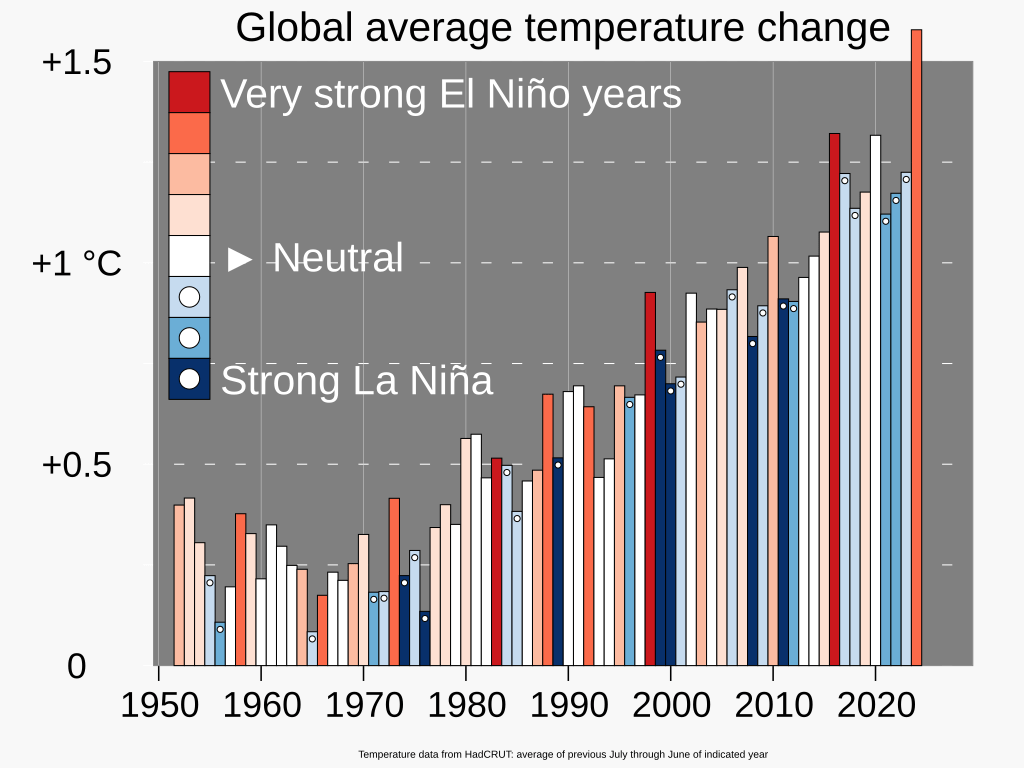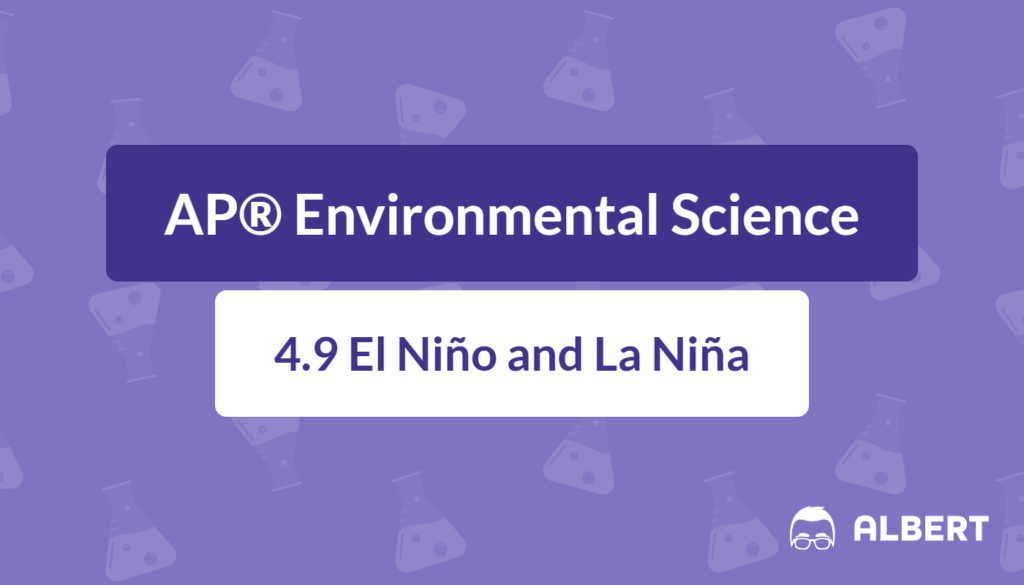What We Review
Introduction
El Niño and La Niña events have a major influence on weather patterns around the world. These complex phenomena involve shifts in ocean surface temperatures, wind patterns, and rainfall distribution. The cycle that includes El Niño and La Niña is commonly referred to as the El Niño–Southern Oscillation (ENSO). Understanding ENSO is important for predicting extreme weather events, planning agricultural output, and preparing for potential natural disasters.
This review thoroughly explores El Niño and La Niña, emphasizing their definitions, causes, and global impacts. Each section includes examples and a step-by-step breakdown of these events so high-school students can better grasp the concepts. The goal is to ensure you gain a clear understanding of how El Niño and La Niña occur—and why they matter for AP® Environmental Science.
What Is El Niño?
El Niño is a periodic warming of sea surface temperatures in the central and eastern parts of the tropical Pacific Ocean. It typically develops every two to seven years. During an El Niño event, trade winds (the east-to-west winds over the tropical Pacific) weaken. As a result, warm water that usually stays in the western Pacific migrates eastward.
How El Niño Occurs
- Normally, strong trade winds blow warm surface waters to the western Pacific.
- During El Niño, these trade winds diminish, allowing warm water to push east toward the coasts of South and Central America.
- As the warm water accumulates in the eastern Pacific, it reduces the upwelling of cold, nutrient-rich waters along the coast of Peru and Ecuador.
- The shift in water temperature changes atmospheric circulation and impacts rainfall and storm patterns on a global scale.
Key Characteristics
- Warmer-than-average ocean surface temperatures in the central and eastern tropical Pacific.
- Weakened trade winds.
- Reduced upwelling of cold waters near South America.
- Potential for heavy rainfall in coastal South America.
Impact on Global Weather Patterns
El Niño often changes weather patterns, especially in regions bordering the Pacific Ocean. For instance, there can be increased rainfall in Peru and Ecuador. At the same time, drought conditions frequently develop in places like Australia and parts of Southeast Asia. In North America, El Niño can lead to milder winters in the northern United States and heavier precipitation in the southern states.
What Is La Niña?
La Niña is the opposite phase of El Niño. Instead of warming, it involves a cooling of sea surface temperatures in the central and eastern tropical Pacific. While El Niño brings warmer waters eastward, La Niña amplifies the usual patterns: strong trade winds carry warm waters westward, enhancing upwelling and leading to cooler waters in the eastern Pacific.
How La Niña Occurs
- Under normal conditions, trade winds blow from east to west across the tropical Pacific.
- During La Niña, these trade winds become stronger than usual, pushing more warm water toward the western Pacific.
- With more robust upwelling in the eastern Pacific, sea surface temperatures drop below average along the coasts of Peru and Ecuador.
- This intensified cooling modifies atmospheric circulation, which can shift rainfall and storm patterns worldwide.
Key Characteristics
- Colder-than-average ocean surface temperatures in the central and eastern tropical Pacific.
- Strengthened trade winds.
- Enhanced upwelling of cold, nutrient-rich waters.
- Potential for decreased rainfall in coastal South America.
Impact on Global Weather Patterns
La Niña can lead to heavier rainfall in areas like Australia and Southeast Asia. However, it often causes drier conditions in western South America. In parts of North America, La Niña is commonly associated with colder winters in the northern regions and warmer, drier weather in the southern states.
El Niño vs. La Niña: Key Differences
Both El Niño and La Niña are associated with ocean surface temperature changes in the Pacific, but they produce nearly opposite effects on weather. The table below summarizes their major features:
| Feature | El Niño | La Niña |
| Sea Surface Temperatures | Warmer in east | Cooler in east |
| Trade Winds | Weaker | Stronger |
| Rainfall in Eastern Pacific | Excessive, flooding risk | Reduced, risk of drought |
| Rainfall in Western Pacific | Reduced, risk of drought | Elevated, flooding risk |
| Upwelling of Cold Waters | Weakened | Strengthened |

Effects on Weather
- El Niño: Increased rainfall in the eastern Pacific, higher temperature anomalies in North and South America, and disruption of fish populations due to limited nutrients.
- La Niña: Higher rainfall in the western Pacific, colder winters in some parts of North America, and improved fishing in the eastern Pacific due to abundant nutrients.
Environmental Changes and Effects
Because El Niño and La Niña can dramatically alter wind and ocean circulation patterns, their consequences stretch across continents. Understanding these shifts is vital, especially when studying global climate connections and how environmental factors influence each other.
Global Influence on Weather
- Temperature Changes
- El Niño can result in warm anomalies that affect global temperature averages. La Niña, conversely, can bring cooler-than-average ocean temperatures in specific regions.
- Precipitation Shifts
- Both El Niño and La Niña can tip rainfall patterns. Rain belt changes may lead to floods or droughts on opposing sides of the Pacific.
- Ocean Productivity
- During El Niño, nutrient upwelling declines, reducing fish populations and impacting fisheries. However, La Niña can intensify upwelling, boosting aquatic productivity.
Example: Rainfall Patterns During El Niño (Step by Step)
- Weakened Trade Winds
- During an El Niño, the normally strong east-to-west trade winds subside.
- Warm Water Migrates East
- Because the warm surface water spreads east, there is less upwelling of cold water near the coasts of Peru and Ecuador.
- Increased Evaporation
- The eastern Pacific becomes warmer, promoting more evaporation. This process adds more moisture to the atmosphere.
- Elevated Precipitation
- Once the evaporated moisture condenses, it leads to heavy rainfall along South American coasts and sometimes triggers strong storms.
Each numbered step shows how the weakening of trade winds cascades into increased rainfall, illustrating the connections among ocean surface temperatures, wind patterns, and weather outcomes.
Why Do El Niño and La Niña Matter?
These climate variations are more than just weather curiosities. They have practical, and sometimes serious, implications for agriculture, fisheries, and ecosystem health.
- Agriculture
- Farmers depend on predictable rainfall. During powerful El Niño events, unexpected downpours can destroy crops in one region while droughts hamper harvests in another.
- Fisheries
- Fish rely on nutrient-rich upwelling zones. El Niño reduces the availability of nutrients, leading to lower fish stocks and economic challenges for fishing communities.
- Natural Disasters
- Both El Niño and La Niña make certain areas more prone to storms or flooding. Conversely, they may also heighten drought risks in other locations.
In addition, the geographic characteristics of the Pacific Ocean and surrounding continents can intensify these effects. The influence depends on local geographic features, such as mountain ranges and coastal zones, which can further shape wind and rainfall distribution.
Conclusion
El Niño and La Niña, components of the El Niño–Southern Oscillation, illustrate the interconnectedness of Earth’s ocean and atmosphere. Small changes in the strength of trade winds can trigger large-scale shifts in sea surface temperatures. These shifts, in turn, redistribute rainfall and heat worldwide.
By recognizing the signs of developing El Niño or La Niña events, scientists and governments can plan for risks that include flooding, drought, and disruptions to food supply. This early awareness helps protect both livelihood and life. A deeper understanding of ENSO is an important tool in climate science, guiding research on broader environmental changes and informing strategies to adapt to variable weather patterns.
Important Vocabulary
- El Niño: A climate pattern in which ocean surface temperatures in the central and eastern Pacific become warmer than average, altering global weather.
- La Niña: The opposite phase of El Niño, characterized by cooler-than-average sea surface temperatures in the eastern Pacific and stronger trade winds.
- ENSO: Stands for El Niño–Southern Oscillation, a recurring climate pattern involving fluctuations in ocean surface temperatures and air pressure in the tropical Pacific.
- Trade Winds: Steady winds that blow predominantly from the east to the west across the tropics, influencing ocean currents and weather patterns.
- Upwelling: The process in which deep, cold, and nutrient-rich water rises to the surface, supporting marine life and affecting climate.
- Southern Oscillation Index (SOI): A measure of the difference in atmospheric pressure between Tahiti and Darwin, Australia, often used to track ENSO phases.
El Niño and La Niña will remain key topics in AP® Environmental Science courses. Exploring their causes, effects, and global significance clarifies how Earth’s systems interact. Ultimately, these events remind everyone of the vast and dynamic nature of the planet’s climate, and why even seemingly small changes in the Pacific Ocean can influence weather globally.
Sharpen Your Skills for AP® Environmental Science
Are you preparing for the AP® Environmental Science test? We’ve got you covered! Try our review articles designed to help you confidently tackle real-world AP® Environmental Science problems. You’ll find everything you need to succeed, from quick tips to detailed strategies. Start exploring now!
- AP® Environmental Science: 4.5 Review
- AP® Environmental Science: 4.6 Review
- AP® Environmental Science: 4.7 Review
- AP® Environmental Science: 4.8 Review
Need help preparing for your AP® Environmental Science exam?
Albert has hundreds of AP® Environmental Science practice questions, free response, and full-length practice tests to try out.








